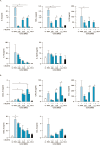Differential plasmacytoid dendritic cell phenotype and type I Interferon response in asymptomatic and severe COVID-19 infection
- PMID: 34473805
- PMCID: PMC8412261
- DOI: 10.1371/journal.ppat.1009878
Differential plasmacytoid dendritic cell phenotype and type I Interferon response in asymptomatic and severe COVID-19 infection
Abstract
SARS-CoV-2 fine-tunes the interferon (IFN)-induced antiviral responses, which play a key role in preventing coronavirus disease 2019 (COVID-19) progression. Indeed, critically ill patients show an impaired type I IFN response accompanied by elevated inflammatory cytokine and chemokine levels, responsible for cell and tissue damage and associated multi-organ failure. Here, the early interaction between SARS-CoV-2 and immune cells was investigated by interrogating an in vitro human peripheral blood mononuclear cell (PBMC)-based experimental model. We found that, even in absence of a productive viral replication, the virus mediates a vigorous TLR7/8-dependent production of both type I and III IFNs and inflammatory cytokines and chemokines, known to contribute to the cytokine storm observed in COVID-19. Interestingly, we observed how virus-induced type I IFN secreted by PBMC enhances anti-viral response in infected lung epithelial cells, thus, inhibiting viral replication. This type I IFN was released by plasmacytoid dendritic cells (pDC) via an ACE-2-indipendent but Neuropilin-1-dependent mechanism. Viral sensing regulates pDC phenotype by inducing cell surface expression of PD-L1 marker, a feature of type I IFN producing cells. Coherently to what observed in vitro, asymptomatic SARS-CoV-2 infected subjects displayed a similar pDC phenotype associated to a very high serum type I IFN level and induction of anti-viral IFN-stimulated genes in PBMC. Conversely, hospitalized patients with severe COVID-19 display very low frequency of circulating pDC with an inflammatory phenotype and high levels of chemokines and pro-inflammatory cytokines in serum. This study further shed light on the early events resulting from the interaction between SARS-CoV-2 and immune cells occurring in vitro and confirmed ex vivo. These observations can improve our understanding on the contribution of pDC/type I IFN axis in the regulation of the anti-viral state in asymptomatic and severe COVID-19 patients.
Conflict of interest statement
The authors have declared that no competing interests exist.
Figures







References
Publication types
MeSH terms
Substances
LinkOut - more resources
Full Text Sources
Other Literature Sources
Medical
Research Materials
Miscellaneous

